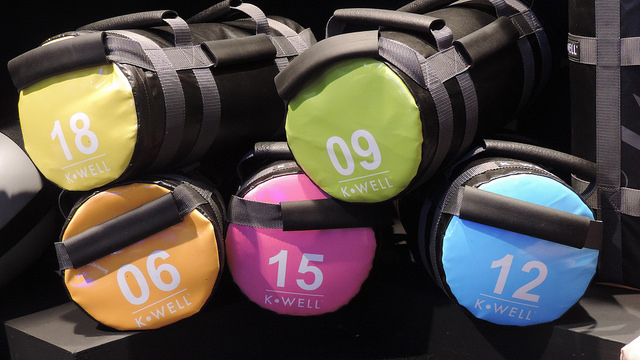
Sandbag training is the exact thing you need if you are looking to increase your strength, power and stability for faster and injury free running.
I love SANDBAGS!
I have been training with sandbags for around 2 years now.
I decided to add them to my training arsenal because I was looking for cheaper ways to spice up my cross-training workouts and add variety to my conditioning routines, and truth be told, sandbag training is an excellent way to do just that.
After 2 years of training with them, I’m really pleased about the range of benefits that sandbag training has to offer. And now I cannot image not having a sandbag in my training program. They are a part of my training program just like my running shoes (I’m, first of all, a runner, duh!), dumbbells, bars, medicine balls, kettlebells, ropes, sliders and my Yoga mat.
Nowadays, I typically use two sandbags that I usually alternate with, one 30 pounds (a home-made bag), and one 60 pounds ( a sport-specific bag I got from Amazon).
The 30-pound bag allows me to do endurance and conditioning exercise with higher reps work, while the heavier bag makes me push harder on the lower rep side, so it’s ideal for building strength.
Benefits of Sandbag Training
Here is a list of the benefits you can reap by doing sandbag training on a regular basis:
Strength & explosive power. The bag is an excellent tool for developing strength and explosive power, both vital for better athletic performance and injury free running. The sandbag can also help you develop core strength in ways that other fitness tools don’t.
A stronger body can better withstand the high impact nature of running, helping you run more efficiently—keys for preventing injury and improving your running performance.
More challenge. The sandbag is the ideal tool to add more variety to your training program, and can make basic movements, like squats and sit-ups, more challenging. It can help you get in a creative and challenging total body workout, at the gym, at home or wherever you have enough space.
No need for a gym. This is why I started sandbag training in the first place. The sandbag is an ideal alternative for helping you get in a high intensity full body workout without running to a gym or paying for hefty fees.
Functional fitness. The type of workouts you can do with a sandbag targets the moves and the muscles you use on a daily basis, helping you do everything in your life with more efficiency. Imagine a workout routine where you can do presses, squats, slams, throws and swings. That’s what sandbag training is all about.
Stabilization. Bags are hard to control since the sand tends to shift around, which is key for learning how to stabilize yourself the entire time. That’s why sandbag training is being used to build strength and joint stability in elite athletes, like fighters, wrestlers and other athletes.
Come in all shapes and sizes. The sandbags come in all shapes, weights, styles, and sizes, and require no advanced technical knowledge on how to use them.

Image Credit – K-Well via Flickr
Burns mad calories. Most sandbag training exercises are full body exercises and will push your body to the max. So expect to shed a lot of calories, and sweat like a madman.
Takes minimum time. Sandbag training exercises are quick and effective. All you need is a good bag, 30 minutes of your time to build up a sweat and provide you with a killer workout.
As a result, whether you are a recreational runner, cyclist, CrossFitter, or an elite marathoner, adding the sandbag to your training arsenal will get you stronger, boost your aerobic and anaerobic power, and help you prevent injury—these, after all, are building blocks of a well-rounded training program
How to Get Started with Sandbag Training
Obviously to get started with sandbag training, you will, first of all, need a bag.
You don’t actually need to invest huge sums of money to start sandbag training. I believe that with a minimum investment, almost any one can get their hands on a sandbag and start training with them right away.
When I originally started training with sandbags, I made my own bag that cost me no more than $4. I just took a 60lb bag of builders sand, then I put it inside of an old but sturdy duffel bag, and I was set to go.
How to Make your Own Sandbag
If you are looking to make your own mid-weight, low-cost sandbag, then here are the three steps you need to take:
- First of all: gather your materials. To make a sandbag you will need: a duffle bag (make sure it’s resilient and can withstand abuse), a builder’s sand bag, sand (duh!), duct tape, and zip ties.
- Next, fill the builder’s bag with sand, wrap the top tightly then seal it tight with duct tape, and zip ties
- Finally, add the builder’s bag of sand directly in the duffel bag, then zip it shut. Make sure to leave enough wiggle room inside of the bag for the sand to splatter around.
Now put the bag to work, and do this powerful bag training routine to help you become the best runner (and athlete) you can be.
For more tips on how to make your own bag, watch the following video:
The Commercial Options
If you don’t want to make your own sandbag, then there are plenty of awesome commercial specialty sandbags designed with hardcore training in mind. I currently use the Ultimate Sandbag ($110– Get it Here). This one is a bit expensive but it can help you do a lot of heavy training.
But if you are looking to something cheaper, then I recommend the SKLZ Super Sandbag ($45 – Get it Here). With a maximum weight of 40 pounds, this one will allow you to do a lot of endurance and power training.

The Ultimate Sandbag Training Routine for Runners
Here is a powerful routine that can help you take your athletic performance and running power to the next level.
Perform the following workout as a circuit, and do the exercises in the order shown, performing as many reps as you can with good form. Shoot for at least three complete sets of the circuit.
1. Sandbag Deadlift
Benefits
Deadlifts are some of the best strength building exercises there is. So push your hardest on this one and lift as much weight as you can with good form.
Proper Form
Begin by standing with your feet right next to the bag, then grip the parallel handles or the material of the bag. Next, tuck your toes under the bag, keep a neutral spine, with knees slightly bent, then take the slack out of the bag, and stand up straight, pulling the sandbag up as you lift your back.
Make sure to keep the sandbag close to your legs throughout the lifting motion. Your back should be straight the entire time—never round your lower back when you pick up or lower the bag.
Last up, push your hips back and slowly return to starting position. That’s one rep.
2. Sandbag Power Clean
Benefits
This is a key move for targeting your hamstrings, glutes, quadriceps and shoulders.
Proper Form
Begin by standing behind the bag, feet parallel and at hip width.
Next, while keeping the sandbag closer to your shins, and knee slightly bent, bend over and pick up the bag by the side hands, lift it from the ground, and then explosively pull it upward by extending your knees and hips. Next, and in one fluid movement, descend into a squat, then uncurl the sandbag and take it down to the floor returning to starting position.
That’s one rep.
3. Sandbag Rotational Lunge
Benefits
This is another powerful exercise for the quads, hamstrings, and the entire core.
Proper Form
Begin by grabbing the handles of the sandbag in each hand so that your palms are facing each other.
Next, while standing tall with feet together and sandbag to knee height, step your right leg forward, lunge, then bring the sandbag over your front leg’s knee and rotate through your waist.
Make sure to keep your back flat and core engaged the entire time – allow for no rounding forward, especially as you rotate with the sandbag.
Last up, while keeping your balance, push back to starting position, and switch sides to complete one rep.
4. Sandbag Front Squat
Benefits
This is, by far, one of my favorite squat variations. The sandbag front squat can help you build strong legs, increase core power, improve mobility and flexibility in your lower body
Proper Form
Start with feet shoulder width apart, with toes slightly turned out, then clean the bag to the front position.
Next, push your hips back and squat down until your thighs are parallel to the ground, then drive the hips back upwards and press back to standing.
Squat in a slow and controlled manner and work your hamstrings and glutes as hard as you can.
Make sure to keep your knees tracking over your toes, knees in line with the feet, your elbows tight and body upright the entire time.
5. Thrusters
Benefits
This is the one of the hardest and most challenging full body exercises you can ever do, period.
Thrusters are a mix front squat and overhead press in one explosive mesh. This one works every muscle group from head to toe. It’s also ideal for working both your lungs and muscular system.
So be careful here and do as many reps as you can with good form. Keep in mind that using sandbag makes the exercise much more challenging.
Proper Form
To begin, stand with your feet shoulder width apart, back straight and knees slightly bent, then grab a hold of the bag, pick it up and hold it at shoulder height.
Next, while keeping the weight at chest heights the entire time, squat down, pause for a moment, then stand back up and push press the sandbag overhead until your arms are almost locked out.
Last up, return the weight to the chest and repeat the movement to complete one rep.
6. Around the World
Benefits
This is an excellent move to work on your shoulder, core and grip strength.
Proper Form
Stand with your feet shoulder width apart, and hold a sandbag in front of you.
Next, pivot to your right and use your whole body to swing the bag quickly over and in a circle over your head to the left side. Make sure to generate enough momentum and to keep your elbows in tight to prevent shoulder injury.
Instead of slowing down use your arms, legs and core to swing the sandbag back to its original position, and complete one rep.
Repeat for 8 reps to complete one set.
Conclusion
The above sandbag training workout can help you run your best and build an injury-proof body. But you have to take action on it and start doing the sandbag exercises ASAP. Otherwise, you have just wasted your time reading this.
Therefore, take action NOW.
In the meantime thank you for reading my post.
Feel free to leave your comments and questions below.
Cheers
David D.
Featured Image Credit – Eugene Mann via Flickr.
Note:This post contains affiliate links. For more check my privacy policy.
Original article and pictures take www.runnersblueprint.com site
Комментариев нет:
Отправить комментарий